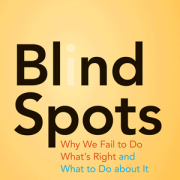Managing Business Ethics
Managing Business Ethics: Straight Talk About How To Do It Right
by Linda K. Treviño and Katherine A. Nelson
John Wiley & Sons, Inc., 5th ed. (2011) (public library)
Summarized by David Newman
Overview
Treviño and Nelson present a fresh look at management as an exercise in shaping human behavior. Replete with psychological research on moral judgments and conduct, as well as dozens of detailed cases drawn from ethical quandaries faced by real-world organizations, this text functions both as a teaching tool and as a practical guide for how employees and managers should comport themselves in difficult situations. Managing Business Ethics tackles its subject matter both prescriptively and descriptively, treating the people in its examples critically but fairly as entities influenced by complex environments of interlacing and often competing systemic pressures. As the authors develop their frameworks, they apply the concepts across multiple dimensions, dealing with not only managers and organizations but employees and stakeholders of all kinds.
Application to Ethical Systems
Managing Business Ethics takes the view that ethical and unethical conduct are primarily the product of how systems align within an organization to promote certain kinds of behavior. The authors start from the assumption that most people wish to behave ethically. They then show how intelligent systems design can encourage managers and employees to follow their predispositions for cooperation and uprightness. Throughout the text, Treviño and Nelson introduce practical suggestions to guide organizational culture toward this goal (e.g., audits of cultural systems)–and address difficulties and pitfalls that lead to the breakdown of ethical systems. With detailed references to historical crises (e.g., the financial collapse), they immerse their readers in the nitty-gritty of how individuals and organizations respond to ethical dilemmas and catastrophic circumstances. The result is a comprehensive learning experience that finds wisdom in both success and failure, which may prepare future generations of professionals to wrestle with tough situations in an increasingly complicated global business environment.
Chapter Summaries
Preface: Why Does the World Need Another Business Ethics Text?
“We want to make the study of ethics relevant to real-life work situations. We want to help businesspeople regain the trust that’s been squandered in the last few years.” The book differs from other business ethics texts in five key ways:
1. It is written by a duo of authors combining decades of experience in both theory and practice.
2. Its approach is pragmatic, assuming that organizational ethics is about human behavior.
3. Its examples are based on real incidents, which students and employees will likely encounter.
4. With help of students and managers, the material was tested in universities and corporations.
5. Organized to be flexible, the book’s sections stand alone and may be taught in any sequence.
Section I: Introduction
Chapter 1: Introducing Straight Talk about Managing Business Ethics: Where We’re Going and Why
Ethical debacles are a regular occurrence, so business ethics is far from a fad. “It’s an ongoing phenomenon that must be better understood and managed and for which business professionals must be better prepared.” The 2008 financial crisis has created an environment of outrage and mistrust like no other. History has shown that divorcing business from ethics runs huge risks. Capitalism will succeed only when firmly tethered to a moral base, which Adam Smith knew well.
The book describes factors leading to the crisis: cheap borrowing, real estate speculation, bad loan origination, securitization, and failures of raters, risk managers, regulators and legislators. The crisis launched an epidemic of cynicism about business, especially in the U.S., built on the media’s long-standing infatuation with corporate villainy. However, “the business landscape is a varied one that is actually dominated by good, solid businesses and people who are even heroic and extraordinarily giving at times.” We must recognize those who are “doing things right.”
The authors state that ethics can be taught, so organizations must look for systemic causes of unethical behavior. Relying on a managerial approach, they define ethical behavior in business as “consistent with the principles, norms, and standards of business practice that have been agreed upon by society.” Evidence shows we are motivated by economic and moral concerns. Ethics is important and beneficial to employees, managers, leaders, industries and society. Among the more elusive benefits of ethics are trust (essential in a service economy) and values (“one’s core beliefs about what is important, what is valued, and how one should behave across a wide variety of situations”). Both are needed for well-functioning organizations and societies.
The ethical decision-making process proceeds from Ethical Awareness to Ethical Judgment to Ethical Behavior. It is influenced by the characteristics of individuals (e.g., personal differences, cognitive biases) and by the characteristics of organizations (e.g., group pressures, culture).
Section II: Ethics and the Individual
Chapter 2: Deciding What’s Right: A Prescriptive Approach
A true ethical dilemma puts two or more “right” values in conflict. One should use multiple approaches to think carefully about the issues and avoid falling into a solution by accident.
1. Consequentialism (teleology): utilitarianism can be practical but cumbersome to calculate.
2. Duties and principles (deontology): focus on correct action, rights or a categorical imperative. However, it can be difficult to decide which duty, right or principle takes precedence in a clash, and this approach faces troubles when following rules might lead to devastating consequences.
3. Integrity (virtue ethics): consider the actor’s character, motivations and intentions. Rules and consequences are considered in the context of assessing the actor’s integrity, as defined by a relevant moral community that holds you to the highest ethical standards. But which community? Options include a professional association, regulatory community, religious group, your family or the broader public–but not your work group or organization (unless in a highly ethical context).
The authors offer eight steps to integrate these three types of analysis: (1) Gather the Facts, (2) Define the Ethical Issues, (3) Identify the Affected Parties, (4) Identify the Consequences, (5) Identify the Obligations, (6) Consider Your Character and Integrity, (7) Think Creatively about Potential Actions, and (8) Check Your Gut. They also suggest practical guidelines both for when you have time to “do your homework” and for when you are asked to make a “snap decision.”
Chapter 3: Deciding What’s Right: A Psychological Approach
The ethical decision-making process consists of (1) ethical awareness, (2) ethical judgment, and (3) ethical action. The first step involves recognizing the ethical nature of the situation at hand, a task that activates specific parts of the brain associated with emotional processing. Awareness will more likely arise if prompted by social environment, ethical language “framing” the situation, or the potential for serious harm to others. Managers should use these cues to promote ethics.
As with awareness, neuroscience research is finding that ethical judgment is a unique form of decision-making. The authors present several ways in which individuals differ in their judgments:
1. Ethical decision-making style: people prefer prescriptive ethical theories based on our tendencies toward idealism (concern for others’ welfare) or relativism (emphasis on situation-dependency).
2. Cognitive moral development: discussion of Kohlberg’s six-stage model of moral cognition.
3. Locus of control: perception of the control one exerts over events (internal-high, external-low).
4. Machiavellianism: associated with unethical action, this should be a red flag for managers.
5. Moral disengagement: to varying degrees, individuals can use certain mechanisms to engage in unethical behavior without feeling bad about it. The authors describe several of these tactics.
Cognitive biases often impede our ethical judgment, impairing how we gather facts, think about consequences, evaluate integrity, and use our gut. Unconscious biases affect how we value different people (young/old, black/white), and emotions (while necessary for ethical judgment) can interfere with good decision-making when they tilt too far against our ability to be rational.
Chapter 4: Addressing Individuals’ Common Ethical Problems
This chapter addresses typical ethical problems individuals face at work as well as their costs. It also suggests how people can try to identify their values and voice them. Among the issues are:
1. People issues: the ethical problems that occur when people work together. They can include privacy, discrimination, harassment (sexual and otherwise), and simply how people get along.
2. Conflicts of interest: these occur when your judgment or objectivity is compromised. Your capacity and reputation for impartiality are key to your end of the employer-employee contract. Common conflicts involve bribes (overt or subtle), personal influence, and privileged information.
3. Customer confidence issues: these include confidentiality, product safety and effectiveness, truth in advertising, and special fiduciary responsibilities. Preserving your reputation is essential.
4. Use of corporate resources: because you represent your company, your actions can be regarded as those of the corporation. You must be truthful with your employer and management and responsible in the use of corporate resources, including its finances and reputation.
Occasionally you will find yourself with knowledge about serious wrongdoing, and blowing the whistle (either internally or externally) may seem like your only option. Here voicing your values at work can require significant courage, which you should think about as “calculated risk taking.” If all facts, advice and policies impel you to blow the whistle, the authors suggest seven steps:
1. Approach your immediate manager first.
2. Discuss the issue with your family.
3. Take it to the next level of management.
4. Contact your company’s ethics officer or ombudsman.
5. Consider going outside your chain of command.
6. Go outside of the company.
7. Leave the company.
Section III: Managing Ethics in the Organization
Chapter 5: Ethics as Organizational Culture
The ethical culture of an organization is a “slice” of the larger organizational culture that represents the aspects of the culture that affect how employees think and act in ethics-related situations. Most employees look outside themselves for guidance about how to think and act. Ethical culture can influence employees to do either the right thing or the wrong thing. A culture can be strong, with widely shared standards, or it can be weak, with strong subcultures guiding behavior in different ways. Individuals are socialized into an organization’s culture, but they may also internalize values that accord with their own beliefs, making for a very smooth transition.
Ethical culture is a multisystem framework of formal and informal organizational systems. To have a fully aligned ethical culture, the systems must all send employees consistent messages that point in the direction of ethical behavior. Cultures can range from strongly aligned ethical cultures to strongly aligned unethical cultures (where all systems support unethical behavior).
| FORMAL SYSTEMS | INFORMAL SYSTEMS |
| Executive Leadership | Role Models/Heroes |
| Selection system | Norms |
| Policies/Codes | Rituals |
| Orientation/Training | Myths/Stories |
| Performance management | Language |
| Authority structure | |
| Decision processes | |
| Alignment? | |
The authors offer further frameworks to examine how leaders create, maintain or change culture:
| Executive Ethical Leadership is about Reputation, Which Rests on These Two Pillars | |
| Moral Person | Moral Manager |
| Tells followers how leader behaves | Tells followers how they should behave and holds them accountable |
| Traits | Role Modeling |
| Honesty, Integrity, Trust | Takes visible ethical action |
| Behaviors | Rewards/Discipline |
| Openness, Concern for people, Personal morality | Holds people accountable for ethical conduct |
| Decision making | Communicating |
| Values-based, Fair | Sends an “ethics and values” message |
| Executive Ethical Leadership Reputation Matrix | |||
| Moral Person | |||
| Weak | Strong | ||
| Moral Manager | Strong | Hypocritical leader | Ethical leader |
| Weak | Unethical leader | ? | |
| <– Ethically neutral leader –> | |||
Beyond specific systems, employees’ perceptions of broad climates within the organization are extremely fundamental and influential. Fairness, benevolence, self-interest, and principles (or rules) may all form the basis for climates that affect employee behavior.
The authors go on to describe how an ethical culture may develop and change, from ethical to unethical or vice-versa. Conscious change requires simultaneous and systematic attention to all cultural systems, and the only way to determine if the culture is aligned to support ethical behavior is to conduct regular, comprehensive audits of all relevant cultural systems. The development of organizational culture requires a long view–as much as 6 to 15 years. Employees should participate in the problem diagnosis and planning process.
Chapter 6: Managing Ethics and Legal Compliance
Partially because of media attention to American business scandals, many businesses are allocating resources to formal ethics and legal compliance programs. But the largest influence on corporate ethics programs has been from the U.S. Sentencing Guidelines, which have trended toward increasing fines for both individuals and organizations convicted of felony crimes. The Guidelines have encouraged the use of ethics programs, corporate ethics offices, compliance officers, and even ethics committees staffed by senior-level managers.
Within the ethics infrastructure, good communication is essential for a strong, aligned culture. The authors discuss principles for the implementation and evaluation of ethics communications, including mission or values statements, organizational policy, codes of conduct, ethics training, and systems to resolve questions and report ethical concerns. They also distinguish ethics initiatives that emphasize values (proactive and aspirational) from those that emphasize compliance (focusing on required behavior as opposed to lofty ethical principles). An effective program should have both values and compliance components. The chapter concludes with an example of how to globalize an ethics program, drawn from United Technologies Corporation.
Chapter 7: Managing for Ethical Conduct
The authors introduce basic management concepts to promote ethical employee behavior, assuming (1) managers want to be ethical, (2) managers want their subordinates to be ethical, and (3) managers’ experience will offer insight into the unique ethical requirements of the job. Generally, the authors advocate thinking of ethics in concrete behavioral terms: what kind of behavior are you looking for in your subordinates, and how can you support that behavior?
The chapter lays out examples to illustrate how people have “multiple ethical selves,” behaving differently depending on context. It then suggests a number of practical ideas for how managers can create an ethical environment, using rewards, discipline, and goals. Managers should also be conscious of how unethical behavior can be encouraged or rationalized through group norms. People tend to fulfill assigned roles, which may reduce awareness of personal responsibility through deindividuation. However, roles can also support ethical behavior (e.g. “whistle-blower”). Lastly, the authors show how extant research on obedience to authority (cf. Milgram) and diffusion of responsibility applies to organizational behavior and management.
Chapter 8: Ethical Problems of Managers
Because managers are role models for their departments, they must be able to discuss the ethical implications of decision-making and provide advice to employees in an ethical quandary. The authors believe that ethical behavior is closely intertwined with employee engagement and present a framework of three groups along an engagement continuum:
| Actively Engaged | Not Engaged | Actively Disengaged |
| Passionate and enthusiastic | “Checked out” | “It’s not my job.” |
| Feel profoundly connected to the company | Sleepwalking | Negative drag on the culture |
| Drive innovation | Put time–but not passion or energy–into their work | Little or no company loyalty |
| Move the company forward | May or may not go the extra mile | Undermine what engaged coworkers accomplish |
| Eagerly go the “extra mile” | May well sabotage company initiatives and employee goodwill |
There are four drivers of engagement: (1) line of sight (understanding the company’s values, operations and strategic direction), (2) involvement, (3) information sharing, and (4) rewards and recognition. Particular manager behaviors are more effective at increasing engagement and ethical culture, such as interest in employee well-being, communication, accessibility, and consistency.
The chapter describes how to manage the “basics”: hiring and work assignments, performance evaluation, discipline, and terminations–and reviews the costs associated with mismanagement. It goes on to suggest how to manage diversity, harassment, and family and personal issues. In addition the authors cover the role of the manager as the “lens through which employees view the company as well as the filter through which senior executives view employees.”
Finally, they offer advice for workers to “manage up and across” in team situations. The increasingly popular institutionalization of 360-degree feedback means that workers need to carefully consider all of their work relationships and maintain high standards of ethical behavior.
Section IV: Organizational Ethics and Social Responsibility
Chapter 9: Corporate Social Responsibility
The authors suggest three reasons that corporations should care about social responsibility:
1. Pragmatic: business must use its power responsibly in society or risk losing it. The perception of the corporation as a responsible social actor is dependent on multiple stakeholders’ views.
2. Ethical: responsible executives have an ethical duty to care about multiple stakeholders because it is the right thing to do. Social responsibility is as integral as economic performance.
3. Strategic: business needs a healthy society because only a healthy society can produce a productive workforce and the rules that make business transactions possible.
Another way to think about corporate social responsibility (CSR) is in terms of multiple types of responsibility: economic, legal, ethical, and philanthropic. Each type builds on and goes beyond the prior type of responsibility, much like a pyramid, which the authors flesh out with examples.
Yet another way to think about CSR is the “triple bottom line”: a firm’s economic, social, and environmental impacts. “Sustainability” has at times been used to indicate harmony among these dimensions, and at times it has been associated more with environmental impact.
Socially responsible business is good business because of (1) the benefit of a good reputation, (2) rewards from socially responsible investors, (3) the cost of illegal conduct, (4) the cost of government regulation, (5) the positive effects of social responsibility on firm performance, and (6) the fact that social responsibility is right in itself. The authors cite specific examples for each.
Chapter 10: Ethical Problems of Organizations
This chapter looks at a series of business ethics and social responsibility cases within the framework of stakeholders, both primary and secondary. Primary stakeholders are those groups or individuals with whom the organization has a formal, contractual relationship (customers, employees, shareholders, owners, suppliers, and perhaps the government). Secondary stakeholders are other individuals or groups to whom the organization has obligations.
The authors apply many of the concepts of Chapters 4 and 8 on a larger scale, describing real-world examples of ethical quandaries involving conflicts of interest, product safety, advertising, employee safety, employee downsizings, duties to shareholders and other owners, and obligations to the community writ large. The chapter includes analysis of many of the more memorable business ethics cases (e.g. Enron, the AIG bailout, Exxon Valdez).
Ch. 11: Managing for Ethics and Social Responsibility in a Global Business Environment
With the increasing globalization of business, many managers find themselves in an international environment full of ethical challenges, facing greater numbers of stakeholders, foreign languages and cultures, and high-level issues such as corruption, money laundering, human rights abuses, substandard workplace conditions, environmental impact, respect for local cultures, and more.
The authors begin with a focus on the difficulties faced by the individual expatriate manager, such as: (1) the difficulties of foreign business assignments, (2) the need for structure, training, and guidance, (3) foreign language proficiency, (4) learning about the culture, (5) recognizing the power of selective perception as influenced by culture (e.g. individualism vs. collectivism), (6) assumptions of behavioral consistency (how people interact with insiders vs. outsiders), (7) assumptions of cultural homogeneity, (8) assumptions of similarity (the U.S. and Canadian markets are not as similar as one might think), (9) ethics-related training and guidance (to deal with negotiations, payoffs, and bribes), and (10) development of corporate policies for global business ethics (ethical imperialism vs. ethical relativism).
Organizations in a global business environment, or those considering doing business in a foreign country, may need to develop a transcultural corporate ethic, the result of intergovernmental agreements reached in the last half-century, promulgating guidelines based on four principles:
1. The inviolability of national sovereignty: multinationals must respect the “host country’s economic and social development and its cultural and historical traditions.”
2. Social equity: pay scales are expected to ensure equity of genders, races, and ethnicities.
3. Market integrity in business transactions: restrictions on political payments and bribery assume that these “inject non-market considerations into business transactions.”
4. Human rights and fundamental freedoms: this principle is based on belief in the inherent worth of every individual and the equality of rights of all human beings, but it often stands in conflict with national sovereignty (e.g. South African apartheid, treatment of women in many cultures).






